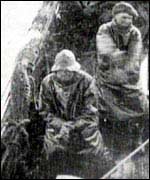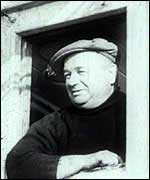|
'Time and Tide' reflects the hardship and tragedy experienced
by East Coast fishermen.
Fishermen do not like to talk about people lost at sea
or the risks involved in fishing. 'Life is for living, not for worrying'.
But everyone in a fishing town knows of someone who has died at sea.
When a man is missing the whole clan get together to look
for the body and help out his family. The Lifeboat Association rescue
grew in parallel with the fishing industry.
A 24 hour job
Fishing was known to be one of the more arduous occupations
a man could choose to earn a living.
 |
|
Fishing was a 24 hour job |
A fisherman's day could be 24 hours long, with most of
the hauls made at night. The little rest that was available was taken
lying on a bone hard locker.
Denied a normal family life or social activities, fishermen
risked their lives in all weathers for little reward. Even as late as
1939, deep sea fishing was described as Britain's most dangerous job.
The War had thrown people together, broadening horizons
and raising expectations of a different life for returning heroes.
A better life
Men left the trade for the navy or mercantile marine. Fishermen wanted
to provide for their sons a better start than they had had.
Before World War II, nine out of ten boys went to sea,
but after the War, more and more boys, even the lads from the Orphan Boys
Home, were found other employment.
The supply of fisherboys dried up and the consequences
were serious. Skills that had been handed down for years from master mariner
to apprentice might be lost within a generation.
The Trawlers
Many trawlers at the turn of the 1900s were still made
of wood, which had been a successful medium for hundreds of years.
Iron and steel hull-shells were replacing the older ships
in the fishing industry, although many wooden boats are still afloat.
 |
|
Steaming ahead |
The first Steam Trawlers sailed towards the end of the
19th century. The size of trawlers was limited by cost, and the size of
the opening to the fish docks.
A steam trawler crew usually consisted of nine men. The
men spent weeks out at sea and were only home for a few days.
They partied hard when they had the chance and the harbour
towns were packed with pubs catering to the fishermen's habit of binge
drinking.
Relationships could be difficult, there was tension between
the fishermen and their loved ones.
Not only might they die at sea, but they led reckless
lives on shore as well. Failed marriages were common place.
For those fishermen from other ports, away from home for
long periods, brawling and prostitution seemed to go with the territory.
A fisherman's wage has always come from his share of the
catch. This 'great gamble' was a part of the attraction, one week nothing,
the next a huge haul.
Safety at sea
 |
|
Safety
first - danger on board |
The problems of safety at sea aboard deep sea trawlers
were not properly addressed until the loss of three Humber trawlers during
the winter of 1968.
The deck operations, especially in bad weather, posed
many dangerous situations if the utmost care was not taken and the proper
procedures not adhered to.
The proper maintenance of deck equipment was essential
and this included adequate service between trips when the vessel was in
dock.
Safety advances were;
The introduction of improved hauling operations
to the majority of trawlers using heavy bobbin trawls.
Development of a hydraulically-operated towing
block for trawls
De-icing the masts and stays with a form of rubber
sleeving and the superstructure with sets of rubber panels.
Icing up was an ever present danger in the northern waters.
Freezing temperature caused a steady build up of ice on superstructures.
If the ice was not removed then capsize was inevitable.
At least three de-icing systems were devised;
The Palmer de-icers used compressed air to expand
the rubber and thereby shatter the base of the ice formation, making it
break off.
The Dunlop de-icer utilised heating elements within
the rubber panels and the heat generated kept the panel and surrounding
area clear of ice formation.
A third idea was a paint that conducted electricity
and kept the superstructure clear of ice.
The commonest form of de-icing was to physically remove
the ice with heavy blunt tools!
Automated mechanisms and design
 |
|
Stern trawlers helped to improve
safety |
Additional mechanisation to conventional trawlers was
a further safety feature inasmuch as a reduction in manual work led to
less fatigue.
Fatigue is one of the prime sources of human error aboard
ship and a reduction in this direction aimed at increased safety.
The greatest advance in safety came with the advent of
the stern trawler and the stern trawler with shelter deck facilities for
the crew was an even greater advance.
No longer did the deckhand have to gut the fish in the
open with the hazards of extreme weather conditions to contend with. Now
he could do all this under cover and in comparative safety.
Fire! fire! fire!
Much was done to minimise the danger of fire aboard these
vessels and a good deal of advance warning equipment for fire conditions
had been introduced.
This had been fitted along with remote warning systems
for engine-room and automatic or semiautomatic fire extinguishing systems.
Three new systems were introduced.
The Monalert engine alarm system provided a remote
alarm system, both in the wheelhouse and the engine-room, covering engine
oil pressures, fresh water temperature, engine overspeed, air pressure
control, oil levels and bilge and fishroom slush well levels. Should any
of these exceed pre-set levels, then the respective alarm was sounded
both in the wheelhouse and in the chief engineer's berth.
The Minerva fire defence system provided a detection
system for both fire and heat. Sensors were located at strategic points
throughout the accommodation and engine-room spaces. In the accommodation
areas and alleyways smoke detection units were located whilst in the galley
and engine-room spaces heat detection equipment was linked to the alarm
system.
A comprehensive fire extinguishing system. This
was semiautomatic and comprised a sprinkler system for the accommodation
and a Multispray system for the engine-room.
The inflatable life raft
The greatest advance in lifesaving equipment was the introduction
of the inflatable life raft aboard fishing vessels.
Fishing vessels found the inflatable life raft to be a
real lifesaver.
Before this the trawler crew had to rely on a standard
wooden lifeboat which as often as not afforded less hope for survival
than the vessel they were abandoning.
Unseen Danger
Unguarded winches, ropes and wires under extreme
tension.
The hazards of using gutting knives when the ship
was rolling and tumbling about.
Exposure to the weather
Noise, which often spread beyond the engine-room
and pervaded the whole accommodation, so that those off-watch had to put
up with it as well. The level of sound in the average engine-room was
well-nigh intolerable. Admittedly, humans can adapt to such conditions,
but it does not mean that this was at all desirable, as excess noise is
definitely harmful, not only to the eardrums but to the whole nervous
system. Some people have a higher tolerance to noise than others, but
in general noise is a cause of fatigue, strain, and therefore accidents.
Small irritations grow out of all proportion when one cannot get away
from them, as is the case aboard a ship.
Herring girls
A 'fisher girl' would follow the 'Silver Darlings' (herrings)
from May to October down the East coast.
 |
|
Heroines of the herring industry |
It was a hard life, started as early as 15, the 'fisher
girl' carrying her belongings in a wooden or tin 'kist'.
Her bed was called a 'karf' which she would fill with
fresh chaff at each port of call.
She would have to bind her fingers with strips of cotton
torn from flour sacks, to protect them from the sharp gutting knives and
the hard herring jaws.
The Scotch girls, followed the fish down the coast, and
invaded Yarmouth in October, numbering some 5,000.
All around the coastline of Britain were strung temporary
herring stations.
These stations had huts for the accommodation of the female
work force.
|

